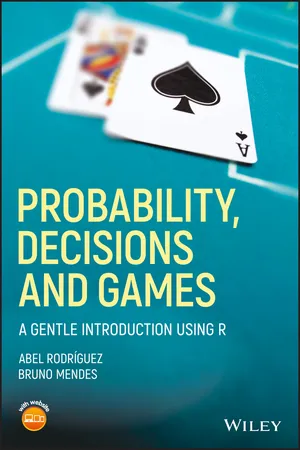
Probability, Decisions and Games
A Gentle Introduction using R
- English
- ePUB (mobile friendly)
- Available on iOS & Android
About This Book
Introduces the fundamentals of probability, statistics, decision theory, and game theory, and features interesting examples of games of chance and strategy to motivate and illustrate abstract mathematical concepts
Covering both random and strategic games, Probability, Decisions and Games features a variety of gaming and gambling examples to build a better understanding of basic concepts of probability, statistics, decision theory, and game theory. The authors present fundamental concepts such as random variables, rational choice theory, mathematical expectation and variance, fair games, combinatorial calculus, conditional probability, Bayes Theorem, Bernoulli trials, zero-sum games and Nash equilibria, as well as their application in games such as Roulette, Craps, Lotto, Blackjack, Poker, Rock-Paper-Scissors, the Game of Chicken and Tic-Tac-Toe. Computer simulations, implemented using the popular R computing environment, are used to provide intuition on key concepts and verify complex calculations.
The book starts by introducing simple concepts that are carefully motivated by the same historical examples that drove their original development of the field of probability, and then applies those concepts to popular contemporary games. The first two chapters of Probability, Decisions and Games: A Gentle Introduction using R feature an introductory discussion of probability and rational choice theory in finite and discrete spaces that builds upon the simple games discussed in the famous correspondence between Blaise Pascal and Pierre de Fermat. Subsequent chapters utilize popular casino games such as Roulette and Blackjack to expand on these concepts illustrate modern applications of these methodologies. Finally, the book concludes with discussions on game theory using a number of strategic games. This book:
- Features introductory coverage of probability, statistics, decision theory and game theory, and has been class-tested at University of California, Santa Cruz for the past six years
- Illustrates basic concepts in probability through interesting and fun examples using a number of popular casino games: roulette, lotto, craps, blackjack, and poker
- Introduces key ideas in game theory using classic games such as Rock-Paper-Scissors, Chess, and Tic-Tac-Toe.
- Features computer simulations using R throughout in order to illustrate complex concepts and help readers verify complex calculations
- Contains exercises and approaches games and gambling at a level that is accessible for readers with minimal experience
- Adopts a unique approach by motivating complex concepts using first simple games and then moving on to more complex, well-known games that illustrate how these concepts work together
Probability, Decisions and Games: A Gentle Introduction using R is a unique and helpful textbook for undergraduate courses on statistical reasoning, introduction to probability, statistical literacy, and quantitative reasoning for students from a variety of disciplines.
Frequently asked questions
Information
Chapter 1
An Introduction to Probability
1.1 What is Probability?





Table of contents
- Cover
- Title Page
- Copyright
- Dedication
- Table of Contents
- Preface
- Acknowledgments
- About the Companion Website
- Chapter 1: An Introduction to Probability
- Chapter 2: Expectations and Fair Values
- Chapter 3: Roulette
- Chapter 4: Lotto and Combinatorial Numbers
- Chapter 5: The Monty Hall Paradox and Conditional Probabilities
- Chapter 6: Craps
- Chapter 7: Roulette Revisited
- Chapter 8: Blackjack
- Chapter 9: Poker
- Chapter 10: Strategic Zero-Sum Games with Perfect Information
- Chapter 11: Rock–Paper–Scissors: Mixed Strategies in Zero-Sum Games
- Chapter 12: The Prisoner's Dilemma and Other Strategic Non-zero-sum Games
- Chapter 13: Tic-Tac-Toe and Other Sequential Games of Perfect Information
- Appendix A: A Brief Introduction to R
- Index
- End User License Agreement